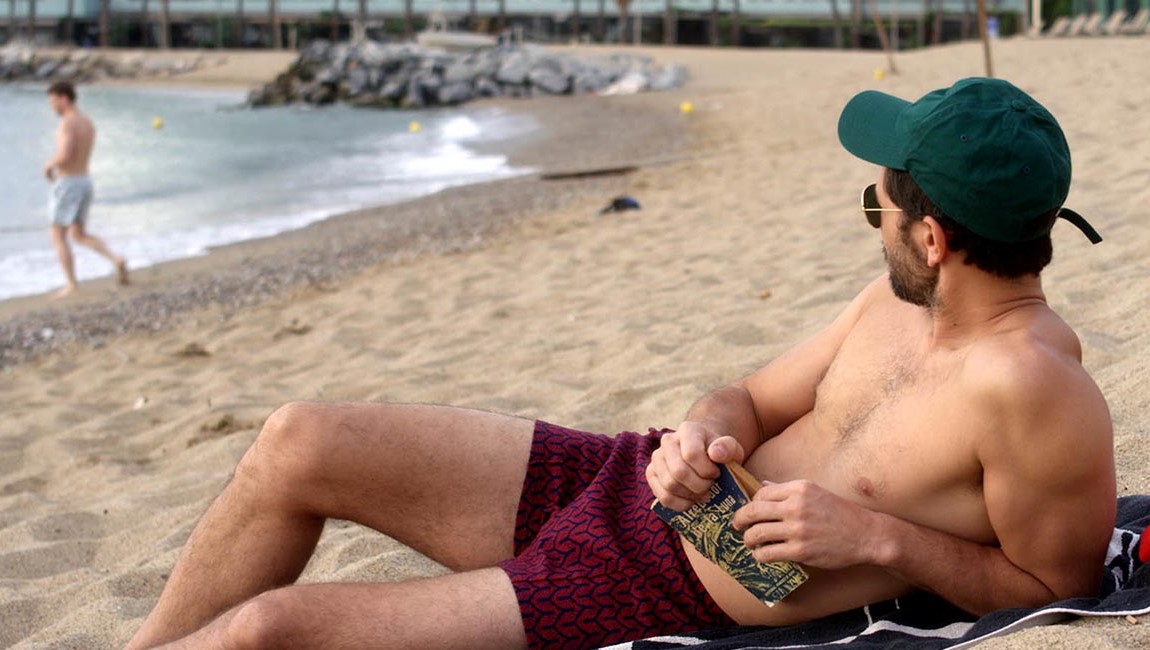Sara Cwynar’s new film Glass Life ends with halting credits that scroll up and down, then back up and back down, over and over, listing a veritable syllabus’ worth of philosophers, theorists, and essayists; names like Adorno, Benjamin, Camus, Dillon, Duras, Heidegger, Lacan (amongst many, many more) flit across the screen like a laundry (or graduate-level seminar) list. It’s not exactly a bibliography, but it speaks to the enormous collaging project that Cwynar is attempting with her films. An offshoot of a pandemic project, Glass Life began as an annotated book collating data, production notes, stills, and texts from Cwynar’s aughts trilogy, comprising Soft Film (2016), Rose Gold (2017), and Red Film (2019). The then-book transformed into a 6-Channel video installation piece, consisting of multiple sequences projecting simultaneously on different surfaces of a gallery space. Without having seen the original installation, it’s hard to know how much this new incarnation of Glass Life, a relatively tidy 20 minutes long, resembles the former. But Cwynar has made clear in the past that her various modes of creation — photography, video installation, and film — are all equally important, with each medium’s formal qualities emphasizing various aspects of her overall project. That project is nothing less than the commodification of both aesthetics and the body by an increasingly aggressive culture industry. Cwynar herself discussed the origins of the film’s title in an artists’ statement in the September 2021 issue of Artforum, saying that “‘Glass life’ is a term coined by Shoshana Zuboff to describe how we are living under constant surveillance without the privacy needed to really form ourselves against the world of images. Our actions are always being monetized. We start to lose who we are. It is presented as a convenience or even a necessity to participate.”
Vaguely resembling the cut-up collage animation of Lewis Klahr on the one hand and the process-oriented tactility of Jessica Rinland’s Those That, at a Distance, Resemble Another on the other, Cwynar arranges her images — magazine ads, old photos, text, 3D graphics — on panes of glass, and then uses optical printing to superimpose these different layers of images on top of one another. She also employs something akin to stop-motion animation to build up and then deconstruct her compositions, the stuttering movements of arms and hands a tell-tell sign of frame-by-frame photography. All of this visual information is overlaid with a dense soundtrack of utterances, quotes, and recitations courtesy of Paul Cooper, who has collaborated on four of Cwynar’s films. But despite the academic jargon on display, Cwynar’s films are playful, frequently quite funny, and feel uniquely handmade. As Michael Sicinski has written, “her work centres on design and display, in particular the visual vernacular of late capitalism. Using both the internalized language of corporate publicity and the hoarder’s logic of consumerist agglomeration, Cwynar’s images treat colour and texture as though the muted, manicured gestures of graphic design suddenly exceeded themselves…” Elsewhere, Phil Coldiron describes Cwynar’s work as a “pile up of words, thick and consistent.”
To wit, Glass Life begins with Cooper’s voiceover accompanying footage of a protest: “In the glass life, everything can be used. It is all material — we are smooth as glass, frictionless, porous, sourceless.” “The sky is falling, Apple stock is rising.” Less than a minute into the film and the soundtrack and images have already conspired at head-spinning speed to unmoor the viewer, allowing only snippets of legible information to emerge. “Will I be nostalgic for this time?” they ask. A repeating beat keeps time in a kind of rhythmic monotone, while a 3D model of a swimming woman bobs and weaves between the foreground and background images. Cut-outs of naked women are juxtaposed with images of Marilyn Monroe, followed by glamor shots of Kim Kardashian. Fingers scroll through a smart phone screen at impossible speeds, the digital animation standing in stark contrast to the magazine pages and 16mm film images. Different textures jockey for attention. “How do you know what size you are in the glass life?” Cooper asks. Optical zooms enlarge images into pixels, mixed with old CRT TV news footage. “Fascism promises you a part in something bigger than yourself, too,” we hear. “The voice is what’s left when signifying is done,” he says, while an adorable pig bitmoji dances across the screen.
Glass Life is ultimately more expansive, more complex than Cwynar’s previous films (fittingly, as it is, in part, a compendium of those works). It’s fully in keeping with her established aesthetic concerns — kitsch, ephemera, items lost to history, the process of creation — while representing a marked increase in ambition and technical achievement. There’s enough visual and aural stimulus here to suggest that one could never exhaust or “master” the film, and that overabundance is certainly part of the point, a bombardment that suggests the entirety of the 21st century crashing down on the viewer all at once. But there is profound beauty here, not just despair. The act of creation reaffirms our humanity in the face of digital obliteration. Glass Life ends with a clear blue sky, the horizon line cutting through the frame in a simple, balanced composition. We get our bearings back just in time. The noise has reverted back to a kind of equilibrium. Maybe that’s the best any of us can hope for.
Published as part of InRO Weekly — Volume 1, Issue 10.







